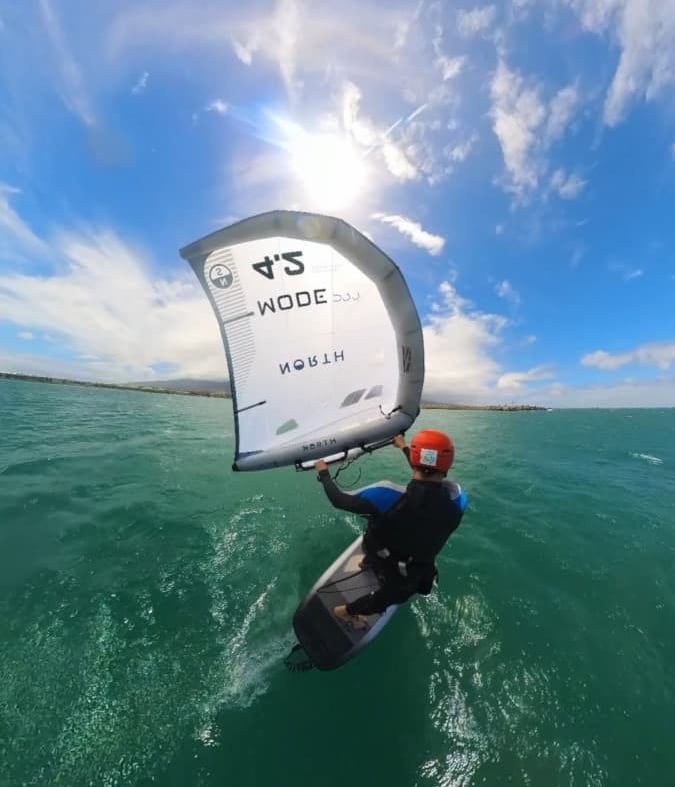Wing Foiling vs. Related Sports: Windfoiling, Kitesurfing & More
Wing foiling has surged onto the watersports scene, but how does it compare to its close cousins like windfoiling, kitesurfing, and stand-up paddleboarding? Whether you’re a newcomer trying to choose a sport or an experienced rider considering crossover, understanding the similarities and differences can help you pick the right path—and equipment.
RM
7/8/20255 min read


Wing Foiling vs. Related Sports: Windfoiling, Kitesurfing & More – Your Ultimate Guide
Wing foiling has surged onto the watersports scene, captivating enthusiasts with its unique blend of freedom and exhilaration. But how does this rapidly growing sport truly compare to its close cousins like windfoiling, kitesurfing, and stand-up paddleboarding (SUP) foiling? Whether you’re a newcomer trying to choose your next aquatic adventure or an experienced rider considering a crossover, understanding the similarities and key differences can help you pick the right path—and the perfect equipment.
What’s Similar & What’s Different: A Quick Overview
Each of these sports offers a distinct feel, gear setup, and riding style. While they all involve gliding on water, the propulsion method and rider interaction vary significantly.
Wing Foiling: Involves standing on a foil board while holding a handheld, inflatable wing. The wing is not attached to the board or a harness, offering immense freedom of movement. It boasts a moderate learning curve and is known for its simplicity and portability.
Windfoiling: This is essentially windsurfing with a hydrofoil instead of a fin. The sail rig is attached to the board via a mast and boom, and riders typically use a harness to manage the power. It allows for high speeds and powerful maneuvers.
Kitesurfing: Utilizes a large kite controlled by lines and a bar, with the rider on a smaller kiteboard. The kite generates significant power, enabling high jumps and aggressive freestyle tricks. It requires more complex gear setup and has a steeper learning curve due to kite control.
Stand-Up Paddleboarding (SUP) Foiling / Downwind Foiling: This discipline focuses on riding ocean swells or bumps without wind propulsion. Riders paddle the SUP foil board to catch energy from the water, lifting onto the foil for a silent, gliding experience.
Pros & Cons: A Deeper Dive
Let's break down the advantages and disadvantages of each sport to help you make an informed decision.
Wing Foiling
Pros:
Simplicity & Portability: The gear is relatively compact and easy to transport, often fitting into a car trunk.
Safety: No long lines or fixed attachments to the board reduce entanglement risks. The wing can be easily depowered by letting go.
Accessibility: Generally considered easier to learn than kitesurfing or windfoiling, making it an ideal beginner water sport.
Freedom of Movement: The unattached wing allows for unique maneuvers and a surf-like feel on waves.
Cons:
Wind Dependence: Relies entirely on suitable wind conditions.
Balance Challenge: Initially, balancing on the foil board while managing the wing can be tricky.
Gear Bulk (Compared to Surf): While portable for wind sports, the board and foil are still bulkier than a traditional surfboard.
Windfoiling
Pros:
Power & Speed: The attached sail rig allows for incredible speeds and powerful upwind performance.
Control: Offers precise control over the foil and direction through the rig.
Familiarity for Windsurfers: A natural progression for experienced windsurfers.
Cons:
Bulkier & More Complex Gear: Mast, boom, and sail make the setup less portable and more cumbersome.
Steeper Learning Curve: Requires significant skill to manage the sail, board, and foil simultaneously, especially for beginners.
Harness & Lines: Involves more rigging and the use of a harness.
Kitesurfing
Pros:
Adrenaline & Airtime: Capable of massive jumps and high-speed maneuvers, offering an extreme sports experience.
Wide Wind Range: Kites come in various sizes, allowing for riding in a broad range of wind conditions.
Maneuverability: Highly dynamic and responsive on the water.
Cons:
Steep Learning Curve & Safety Risks: Requires extensive lessons to master kite control and manage the powerful forces involved. Higher inherent safety risks due to lines and kite power.
Complex & Bulky Gear: Kites, bars, lines, harness, and board make for a larger, more intricate setup, challenging for traveling with water sports gear.
Launch Requirements: Needs open, clear spaces for safe launching and landing.
SUP Foiling / Downwind Foiling
Pros:
No Wind Required: Can be done in flat conditions or by catching ocean swells, offering more flexibility in terms of weather.
Full-Body Workout: Paddling and balancing provide an excellent physical workout.
Quiet & Meditative: Offers a serene experience gliding silently over the water.
Simpler Gear (No Wind Propulsion): Less gear than wind-powered sports, making it easier to manage.
Cons:
Slower: Generally slower than wind-powered foiling sports.
High Balance & Core Strength: Requires excellent balance and core strength to paddle and maintain lift on the foil.
Learning Curve: Mastering the art of catching swells and maintaining foil flight without wind can be challenging.
Who Should Cross Over?
Windsurfers and Kitesurfers: May find wing foiling an easier, less gear-intensive alternative, especially for light wind days or when seeking a more "surf-like" feel.
Wing Foilers: Looking for more speed and power might progress to windfoiling or kite foiling.
SUP Foilers: Can easily transition to wing foiling to add wind propulsion and extend their time on the water, leveraging their existing foil board.
Interchangeable Equipment & Foil Compatibility
A significant advantage in the foiling world is the potential for interchangeable equipment. Many foil boards and hydrofoils are designed with compatible mounting systems (like the Tuttle box or plate mount) that allow them to be used across wing foiling, windfoiling, kite foiling, and SUP foiling with the appropriate rigging. This versatility appeals to multi-sport riders wanting to diversify their skills without investing in entirely new setups for each discipline. Check out our comprehensive gear reviews and compatibility guide for detailed recommendations.
Safety and Travel Considerations
When choosing your sport, consider both safety and travel logistics. Wing foiling gear is generally lighter and easier to travel with compared to bulky windfoiling and kitesurfing setups. Safety protocols differ significantly, with kitesurfing often requiring the most rigorous training due to the power of the kite and the complexity of its lines. Accessibility for beginners is typically highest in wing foiling and SUP foiling due to their simpler initial learning phases and less hazardous gear.
Conclusion: Find Your Flow
Each water sport offers its unique thrills and challenges. Wing foiling strikes a fantastic balance between excitement and accessibility, making it an excellent entry point or a versatile complement to related sports. Whether you're curious about switching disciplines or just starting out, knowing these differences helps you make an informed choice. Ready to dive deeper? Explore our gear reviews and multi-sport school listings to get started on your next water adventure!
Frequently Asked Questions (FAQs)
Here are common questions people ask when comparing wing foiling to other water sports:
1. Is wing foiling easier to learn than kitesurfing or windsurfing? Generally, yes. Wing foiling is often considered easier to learn for beginners compared to kitesurfing (due to simpler gear and no long lines) and windsurfing (due to the unattached, lightweight wing). Many find they can get up and riding on a wing foil board relatively quickly with proper instruction.
2. What are the main differences in gear between wing foiling and windfoiling? The primary difference is how the power is harnessed. In wing foiling, you hold an inflatable wing directly in your hands. In windfoiling, a rigid sail rig (mast, boom, sail) is attached to the board, and riders often use a harness. Windfoiling gear tends to be bulkier.
3. Can I use the same board for wing foiling and SUP foiling? Often, yes. Many modern foil boards are designed as "crossover" boards, meaning they can be used for both wing foiling and SUP foiling (and sometimes even prone foiling or windfoiling) by simply changing the propulsion method (wing vs. paddle) while keeping the same hydrofoil setup.
4. Which water sport is best for travel and portability? Wing foiling generally offers excellent portability compared to kitesurfing and windfoiling, as the inflatable wing packs down small, and the boards are often more compact than traditional windsurf boards. SUP foiling gear (without the wing) is also quite portable.
5. What are the key safety differences between wing foiling and kitesurfing? Wing foiling is generally considered safer for beginners due to the absence of long lines and the ability to easily depower the wing by letting go. Kitesurfing involves powerful kites and long lines, requiring more rigorous safety training and awareness of launching/landing zones.
Connect
Explore wing foiling schools, vendors, and events.
Support
Learn
801-554-1050
© 2025. All rights reserved.
